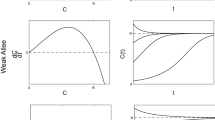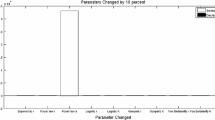Abstract
Finding an appropriate functional form to describe population growth based on key properties of a described system allows making justified predictions about future population development. This information can be of vital importance in all areas of research, ranging from cell growth to global demography. Here, we use this connection between theory and observation to pose the following question: what can we infer about intrinsic properties of a population (i.e., degree of heterogeneity, or dependence on external resources) based on which growth function best fits its growth dynamics? We investigate several nonstandard classes of multi-phase growth curves that capture different stages of population growth; these models include hyperbolic–exponential, exponential–linear, exponential–linear–saturation growth patterns. The constructed models account explicitly for the process of natural selection within inhomogeneous populations. Based on the underlying hypotheses for each of the models, we identify whether the population that it best fits by a particular curve is more likely to be homogeneous or heterogeneous, grow in a density-dependent or frequency-dependent manner, and whether it depends on external resources during any or all stages of its development. We apply these predictions to cancer cell growth and demographic data obtained from the literature. Our theory, if confirmed, can provide an additional biomarker and a predictive tool to complement experimental research.










Similar content being viewed by others
References
Almog N, Henke V, Flores L, Hlatky L, Kung AL, Wright RD, Berger R, Hutchinson L, Naumov GN, Bender E et al (2006) Prolonged dormancy of human liposarcoma is associated with impaired tumor angiogenesis. FASEB J 20:947–949
Benzekry S, Lamont C, Beheshti A, Tracz A, Ebos JM, Hlatky L, Hahnfeldt P (2014) Classical mathematical models for description and prediction of experimental tumor growth. PLoS Comput Biol 10:e1003800
Biebricher CK, Eigen M, William C, Gardiner J (1983) Kinetics of RNA replication. Biochemistry 22:2544–2559
Biebricher CK, Eigen M, Gardiner WC Jr (1985) Kinetics of RNA replication: competition and selection among self-replicating RNA species. Biochemistry 24:6550–6560
Brisken C (2013) Progesterone signalling in breast cancer: a neglected hormone coming into the limelight. Nat Rev Cancer 13:385–396
Chang C-H, Qiu J, O’Sullivan D, Buck MD, Noguchi T, Curtis JD, Chen Q, Gindin M, Gubin MM, van der Windt GJ et al (2015) Metabolic competition in the tumor microenvironment is a driver of cancer progression. Cell 162:1229–1241
Elser JJ, Kyle MM, Smith MS, Nagy JD (2007) Biological stoichiometry in human cancer. PLoS ONE 2:e1028
Fisher RA (1958) The genetic theory of natural selection, 2nd edn. Dover, New York
Folkman J, Kalluri R (2004) Cancer without disease. Nature 427:787–787
Gillies RJ, Gatenby RA (2015) Metabolism and its sequelae in cancer evolution and therapy. Cancer J 21:88–96
Heesterbeek H, Anderson RM, Andreasen V, Bansal S, De Angelis D, Dye C, Eames KT, Edmunds WJ, Frost SD, Funk S, Hollingsworth TD (2015) Modeling infectious disease dynamics in the complex landscape of global health. Science 347(6227):aaa4339
Jozwik KM, Carroll JS (2012) Pioneer factors in hormone-dependent cancers. Nat Rev Cancer 12:381–385
Kapitza SP (1996) The phenomenological theory of world population growth. Phys Uspekhi 39:57–71
Kapitza SP (2006) Global population blow-up and after. Global Marshall Plan Initiative, Hamburg
Karev GP (2005) Dynamics of inhomogeneous populations and global demography models. J Biol Syst 13:83–104
Karev GP (2010) On mathematical theory of selection: continuous time population dynamics. J Math Biol 60:107–129
Karev GP (2014) Non-linearity and heterogeneity in modeling of population dynamics. Math Biosci 258:85–92
Karev G, Kareva I (2014) Replicator equations and models of biological populations and communities. Math Model Nat Phenom 7(2):32–59
Kareva I (2013) Biological stoichiometry in tumor micro-environments. PLoS ONE 8:e51844
Kareva I (2015) Cancer ecology: niche construction, keystone species, ecological succession, and ergodic theory. Biol Theory 10:283–288
Kareva I (2016) Primary and metastatic tumor dormancy as a result of population heterogeneity. Biol Direct 11:37
Kareva I, Hahnfeldt P (2013) The emerging “hallmarks” of metabolic reprogramming and immune evasion: distinct or linked? Cancer Res 73:2737–2742
Kareva I, Abou-Slaybi A, Dodd O, Dashevsky O, Klement GL (2016) Normal wound healing and tumor angiogenesis as a game of competitive inhibition. PLoS ONE 11(12):e0166655. doi:10.1371/journal.pone.0166655
Marusyk A, Polyak K (2010) Tumor heterogeneity: causes and consequences. Biochim Biophys Acta (BBA) Rev Cancer 1805:105–117
Marusyk A, Almendro V, Polyak K (2012) Intra-tumour heterogeneity: a looking glass for cancer? Nat Rev Cancer 12:323–334
Naumov GN, Bender E, Zurakowski D, Kang S-Y, Sampson D, Flynn E, Watnick RS, Straume O, Akslen LA, Folkman J et al (2006) A model of human tumor dormancy: an angiogenic switch from the nonangiogenic phenotype. J Natl Cancer Inst 98:316–325
Peleg M, Corradini MG (2011) Microbial growth curves: what the models tell us and what they cannot. Crit Rev Food Sci Nutr 51(10):917–945
Rogers MS, Novak K, Zurakowski D, Cryan LM, Blois A, Lifshits E, Bø TH, Oyan AM, Bender ER, Lampa M et al (2014) Spontaneous reversion of the angiogenic phenotype to a nonangiogenic and dormant state in human tumors. Mol Cancer Res 12:754–764
Rönn MM, Wolf EE, Chesson H, Menzies NA, Galer K, Gorwitz R, Gift T, Hsu K, Salomon JA (2017) The use of mathematical models of chlamydia transmission to address public health policy questions: a systematic review. Sex Transm Dis 44(5):278–283
Schuster P (2011) Mathematical modeling of evolution. Solved and open problems. Theory Biosci 130:71–89
Spring LM, Gupta A, Reynolds KL, Gadd MA, Ellisen LW, Isakoff SJ, Moy B, Bardia A (2016) Neoadjuvant endocrine therapy for estrogen receptor-positive breast cancer: a systematic review and meta-analysis. JAMA Oncol 2:1477–1486
Tolstikhina OS, Gavrikov VL, Khlebopros RG, Okhonin VA (2013) Demographic transition as reflected by fertility and life expectancy: typology of countries. J Sib Fed Univ Humanit Soc Sci 6:890–896
Tsoularis A, Wallace J (2002) Analysis of logistic growth models. Math Biosci 179(1):21–55
Verguet S, Johri M, Morris SK, Gauvreau CL, Jha P, Jit M (2015) Controlling measles using supplemental immunization activities: a mathematical model to inform optimal policy. Vaccine 33(10):1291–1296
von Forster H, Mora PM, Amiot LW (1960) Doomsday: friday, 13 november, A.D. 2026. Science 132:1291–99
Wirapati P, Sotiriou C, Kunkel S, Farmer P, Pradervand S, Haibe-Kains B, Desmedt C, Ignatiadis M, Sengstag T, Schutz F et al (2008) Meta-analysis of gene expression profiles in breast cancer: toward a unified understanding of breast cancer subtyping and prognosis signatures. Breast Cancer Res 10:R65
Acknowledgements
The authors would like to thank Dr. Senthil Kabilan for his invaluable help with parameter fitting, the anonymous reviewer and Dr. Micha Peleg for their thoughtful and valuable comments and suggestions. This research was partially supported by the Intramural Research Program of the NCBI, NIH (to GK).
Author information
Authors and Affiliations
Corresponding author
Ethics declarations
Conflict of interest
The authors declare no conflict of interest.
Electronic supplementary material
Below is the link to the electronic supplementary material.
Rights and permissions
About this article
Cite this article
Kareva, I., Karev, G. From Experiment to Theory: What Can We Learn from Growth Curves?. Bull Math Biol 80, 151–174 (2018). https://doi.org/10.1007/s11538-017-0347-5
Received:
Accepted:
Published:
Issue Date:
DOI: https://doi.org/10.1007/s11538-017-0347-5




